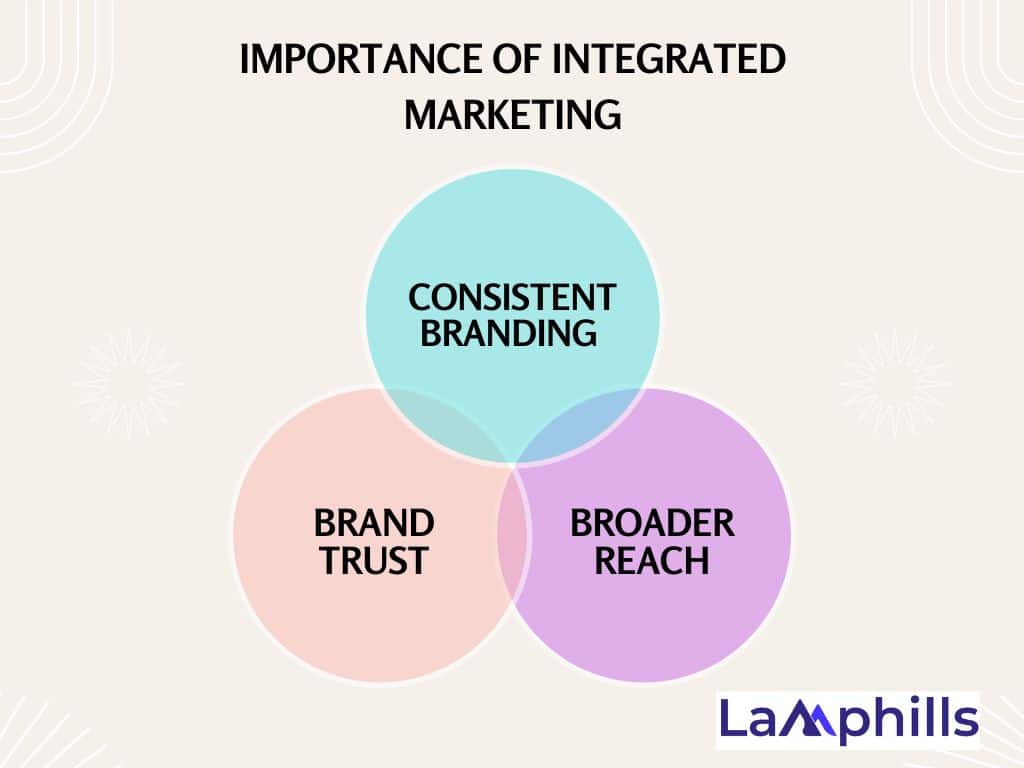One of my favorite marketing strategies is an Integrated Marketing Campaign. I find it exciting to scroll through social media and see how a product, movie, service, or artist’s branding is smoothly adjusted to fit different platforms. It feels more natural and easy to relate to, which makes it simpler to connect with the message, no matter where I see it.
Many marketers believe integrated marketing needs a large budget and a team of experts. But that’s not true. The key is knowing your target audience and what they like.
With new platforms appearing, integrated marketing is growing in popularity. It combines different channels to share one clear brand message with your audience.
This article explains the main parts of a successful integrated marketing campaign and provides examples to help you get started.
Key Points
- An Integrated Marketing Campaign involves promoting a product, service, or brand across multiple platforms using a unified message.
- This ensures consistency and smooth customer experiences across channels like social media, email, TV, and direct mail.
- Various integrated Marketing Campaigns exist, including advertising, sales promotions, direct marketing, public relations, and social media.
- The approach ensures a broader reach, better customer experience, increased efficiency, and stronger brand trust.
- It allows marketers to reach different audiences through various platforms while maintaining a consistent message.
- Successful integrated marketing campaigns from brands like Coca-Cola (“Share a Coke”), Nike (“Just Do It”), and Apple (“Shot on iPhone”) show how unified messaging across multiple platforms can enhance brand engagement and customer loyalty.
What is an Integrated Marketing Campaign?
An integrated marketing campaign is a unified way of promoting a product, service, or brand across different platforms. It combines methods like email, social media, and direct mail to create a smooth and connected experience for the audience. This approach ensures the message stays the same on every platform, making each method work better together.
For example, you might hear a radio ad about a new pair of running shoes. Then, while scrolling through Facebook, you see a video showing athletes using those shoes. Later, when you pass by a store, there’s a window display featuring the same shoes.
This approach helps increase interest and awareness. By using different platforms to deliver the same message, it allows more people to interact with the campaign in various ways.
Note: Integrated marketing is different from multichannel marketing. In multichannel marketing, several channels are used, but they might not work well together. On the other hand, omnichannel marketing connects these channels to create a smooth and consistent customer experience across all platforms.
That said, integrated marketing is not just about using the same logo or slogan on different platforms. It’s more about creating a smooth and consistent experience that supports your message, no matter how people encounter your brand.
Now, marketers have many ways to use integrated marketing campaigns to reach their target audience. Let’s see the types of integrated marketing campaigns.
Types of integrated marketing campaigns
There are different types of integrated marketing campaigns that businesses can use to reach their audience. Each type uses a mix of channels, like social media, TV, print ads, or emails, to share a message clearly and consistently. These types include:
Advertising: Integrated marketing brings together different channels to share the same brand message. It uses a mix of methods, such as newspapers, TV, online ads, and social media.
Sales promotions: Integrated promotional marketing means ensuring the same message, timing, and methods across different channels. This can include store promotions, online deals, direct mail, social media posts, and more.
Direct marketing: Reaching your audience directly through email, phone calls, text messages, or brochures is a method that never goes out of style. It lets you send clear, personalized messages to specific people or groups.
Public relations: Public relations is about connecting and communicating with the public. You can do this through online media, handling crises, and managing important issues. By doing this, organizations can improve how people see them and build a better reputation.
Social media: You can easily connect with current and future customers using social media marketing. Platforms like Facebook, TikTok, Instagram, and LinkedIn allow you to reach a large group of people.
By combining these channels, the campaign becomes more effective in getting people’s attention.
Now that you understand integrated marketing campaigns and their various types, you might wonder why they’re important. Let’s find out.
The Importance of Integrated Marketing

Integrated marketing isn’t just a quick trick or shortcut. It’s a reliable plan that can help your business grow and make more money. Here are reasons why it matters:
#1. Consistent Branding
The beauty of an integrated campaign is that it offers consistency. Imagine you’re launching a new product, and your Facebook post talks about one benefit while your email highlights an entirely different feature. This can leave potential customers unsure about what to expect.
You can keep the same brand message across all channels and platforms with an integrated communication campaign. Using the same style, logos, tone, and headers everywhere helps make your brand look more professional and recognizable.
#2. Better Customer Experience
When your customers encounter the same message across different platforms, they start to trust you more. It feels professional and planned. I recall how the customers of a startup campaign I did began to comment on how everything felt “connected”—the social media ads led them to our website, which directed them to our in-store offers. That seamless experience made them feel valued and ultimately increased their loyalty to the brand.
#3. Broader Reach
You naturally reach a wider audience by spreading a unified message across different platforms. A customer who sees your TV commercial might never hear your radio ads. Using different channels gives you a better chance of reaching a wider group of people. You don’t have to be on every channel, just the ones where your customers are most likely to be.
For example, during a campaign, we noticed that some people would first hear about us through a Facebook ad while others came in through our email campaigns or website blog posts. Having the same message across these platforms made it easier for them to recognize us, no matter where they encountered the brand.
# 3. Increased Efficiency
An integrated campaign also boosts efficiency. Instead of creating a separate strategy for each channel, you can streamline your efforts. When we started doing this, it saved us time, and we could focus our budget on what worked. We realized we didn’t need to spend extra on creating different marketing materials for each platform. One unified strategy was enough to cover them all.
#4. Brand Trust
When customers see the same message from a brand every time they interact with it, they start to trust the brand more. You can also adjust your approach for each channel by using information about your customers and what they like.
#5. Better results
Integrated marketing brings teams together to work as one. Press releases, blog posts, articles, and ads all share the same message, which helps build customer trust.
In summary, integrated marketing campaigns understand that people like to connect with brands in different ways. These campaigns help you share the right message with the right audience at the right time. If it doesn’t do this, it’s not true integrated marketing.
Now, let’s look at some examples of well-known brands that use integrated marketing.
Examples of Integrated Marketing Campaigns
Here, we’ll look at some of the best examples of integrated marketing campaigns using well-known brands. We’ve chosen a mix of campaigns from business-to-business (B2B) and business-to-consumer (B2C) companies.
#1. Coca-Cola’s “Share a Coke” Campaign

Image by Coca-Cola United
One of the most famous examples of an integrated marketing campaign is Coca-Cola’s “Share a Coke” campaign. They didn’t just launch ads on TV—they integrated the message into every channel possible, from social media to physical products. I remember seeing my name on a Coke bottle in a store and being excited about it. That feeling translated across millions of customers worldwide.
Coca-Cola extended the campaign across TV ads, social media platforms where users could share their customized bottles, and even in-store experiences where you could find names on bottles. The key here was that no matter where you encountered “Share a Coke,” the message was clear and consistent: Coca-Cola wanted you to engage with the brand on a personal level.
#2. Nike’s “Just Do It” Campaign
Another great example is Nike’s “Just Do It” campaign. This iconic message has been featured everywhere—on TV ads, billboards, social media, and even on their products. What stood out to me, and still does, is how they’ve maintained that message over the years, making it synonymous with their brand.
During this campaign, Nike aligned their message across various platforms, from athletes’ testimonials in video ads to social media challenges. No matter the medium, the slogan “Just Do It” tied everything together, creating a strong, inspiring message that resonated with millions.
#3. Apple’s “Shot on iPhone” Campaign
Apple’s “Shot on iPhone” campaign is a great example of how to create a consistent message across many channels. They encouraged users to take beautiful photos with their iPhones and share them online. Apple then showcased these photos on billboards, social media, and even TV commercials.
The same message was everywhere: the iPhone takes stunning pictures, just like a professional camera. What made it powerful was how Apple let their customers be part of the campaign, making it more personal and engaging. Whether you saw it on Instagram or driving by a billboard, the message was clear and unified.
#4. Old Spice’s “The Man Your Man Could Smell Like

Image by LinkedIn
Old Spice made a big splash with their humorous campaign, “The Man Your Man Could Smell Like.” It started with a funny TV commercial but didn’t stop there. They extended it to YouTube and Twitter and even responded to fans with personalized videos.
The same bold, funny tone was used across all platforms. No matter where you saw the campaign, whether it was on TV, online, or on social media, the message was consistent: Old Spice is the go-to brand for men’s grooming, and they’re not afraid to have fun with it.
#5. GoPro’s User-Generated Content Campaign
GoPro, the action camera company, uses an integrated approach by encouraging its customers to share videos they’ve captured with GoPro cameras. They promote these user-made videos on their YouTube channel, Instagram, and even on their website.
Everywhere you see GoPro’s content, the message is the same: their cameras capture amazing action shots, and anyone can be a part of their adventurous community. By showcasing real-life experiences from users, they create a sense of belonging and adventure that’s hard to miss, no matter which platform you encounter them on.
These examples show how a clear, unified message can spread across different channels and reach more people, helping brands connect better with their audience.
Before we learn how to create an integrated marketing campaign, let’s first look at the basic things you need to create one.
Key Components of an Integrated Marketing Campaign

Image by Freepik
Here are the key parts of an integrated marketing campaign. These are the main things that make it work well:
1. Consistent Messaging: It’s important to keep the message the same across all platforms. Whether it’s an email or a post on social media, the message should stay the same to help people recognize and trust the brand.
2. Multi-Channel Approach: An integrated campaign uses many ways to reach people, like TV, radio, newspapers, social media, emails, and websites. This helps reach more people by using different platforms.
3. Target Audience: Understanding who you’re talking to is key. Do some research to learn about your audience’s age, preferences, and habits. Then, tailor your message and choose the right platforms based on this information.
4. Strategic Planning: Create a plan that includes your goals, key messages, who your audience is, and which channels you’ll use. A clear plan keeps everyone on the same page and focused on the campaign’s success.
5. Data and Analytics: Track how well the campaign is doing by looking at numbers like how many people are engaging, converting, or what the return on investment (ROI) is. Use this information to improve the campaign.
6. Seamless Integration: Make sure all the different channels and tactics work well together. Everything should fit smoothly so that the audience has a consistent experience across all platforms.
Now, here are simple steps to build an integrated marketing campaign.
How to Create an Integrated Marketing Campaign in Five Steps.
Creating a successful marketing campaign can feel overwhelming, but it doesn’t have to be. The checklist below will guide you through the key steps to ensure your message stays clear, consistent, and effective across different platforms.
Whether you’re just starting or refining an existing campaign, following these steps will help you reach your audience and achieve your goals.
Integrated marketing campaigns help you reach more people, build trust, and increase profits. But how do you create one? Let’s go through the steps.
#1. Set your main goal
Start by deciding what you want to achieve with your campaign. This could be increasing brand awareness, boosting sales, or introducing a new product. Your goal will guide the entire campaign, so it’s important to get it right. You can use the SMART method to create clear and achievable goals.
For example, if you want to grow your customer base, here’s how the SMART method can help:
- Specific: Use social media marketing to attract new customers.
- Measurable: Aim to get 30 new leads.
- Achievable: Expand your reach through a marketing campaign that uses multiple channels.
- Relevant: Your last campaign brought in 20 new leads in a month.
- Time-bound: Start planning next week and launch the campaign by the end of the month.
#2. Know your target audience
To run a successful integrated marketing campaign, you must understand who you’re trying to reach. Don’t guess—use these tips to learn more about your audience:
- Find out which social media platforms they use.
- Understand their challenges and needs.
- Learn about their hobbies.
- Check if they’re interested in buying a product like yours.
- Figure out if they prefer informative or entertaining content.
#3. Choose your marketing channels
Doing research on your audience will help you understand which marketing channels they like to use.
Here are some other things to think about:
- Your goals: What do you want to achieve with your marketing? If building a community is important, focus on social media.
- Your competition: Look at what channels your competitors are using. This will show you what might work for your business and help you stay competitive.
- Your budget: Think about how much money you can spend. YouTube ads or paid advertising can be expensive while starting a blog or using email marketing is usually cheaper.
#4. Create campaign content
Make content for each channel, but keep your brand message the same across all of them. This could include blog posts, social media updates, videos, infographics, and more. Make sure your content is helpful, engaging, and relevant to your audience.
You can try different types of content to see what works best. But whatever you create, always stick to your brand’s style, colors, and tone. To keep everything consistent, it helps to write down a style guide that defines your brand’s voice and look.
#5. Launch and check performance
Tracking and understanding results is really important for creating successful integrated marketing campaigns.
It helps you improve your strategies and use your resources more wisely. Also, marketing automation ensures that your efforts match your goals and give you the best return on investment (ROI).
The things you should measure depend on your specific goals, but here are some common marketing metrics most businesses care about:
- Social media likes, comments, and shares
- Click-through rates (CTR) from email campaigns
- Website visits
- Search engine rankings
- The cost of acquiring a new customer
Conclusion
In conclusion, Integrated Marketing Campaigns are a powerful tool to ensure that your brand message cuts through the noise, reaches the right audience, and sticks with them. From my experience, it has proven to be a game-changer in driving both engagement and sales. Whether you’re a small startup or a global brand like Nike or Coca-Cola, the principles remain the same: consistency, efficiency, and connection.
So, next time you think about running a marketing campaign, remember: that it’s not just about posting content on different platforms. It’s about creating a unified, impactful experience that tells a story, no matter where your audience finds you. And that’s when you’ll start to see the magic happen.
Frequently Asked Questions.
What is an integrated media campaign?
An integrated media campaign uses different channels like content, email, online ads, and social media to share the same message with a specific group of people.
The main goal of an integrated campaign is to turn viewers into customers.
What are integrated media activities?
Integrated media campaigns are strategies that use different channels and formats to share a clear, consistent message with a specific audience. By combining the unique strengths of each media platform, they help you reach more people, get them involved, and encourage them to take action.
What does “integrated” mean in media?
Integrated media is when businesses use different types of media together to share their message with people. This can include a mix of traditional media (like newspapers and billboards), digital media, TV and radio, or even product packaging.
What is an example of an integrated marketing campaign for an event?
An integrated marketing campaign for an event involves promoting a sports, entertainment, or company event using different channels. Examples include concerts, festivals, fairs, sports tournaments, pet adoption days, and charity events.
How does Coca-Cola use integrated marketing?
Coca-Cola uses many different methods to promote its products. This includes TV ads, printed ads in magazines or newspapers, and online banner ads. They mix advertising on mass media, direct marketing, and promotions on websites and social media to reach more people and boost sales.
What are IMC tools?
IMC (Integrated Marketing Communication) tools help businesses improve their marketing. These tools include advertising, online marketing, public relations, direct marketing, and sales promotions.
These promotional methods work best when they are used together instead of separately. This way, the message reaches more people and has a stronger impact.
What is a full IMC plan?
A fully integrated marketing communications (IMC) plan includes several steps to make a marketing campaign successful. These steps are: doing market research, creating a strategy, understanding the target audience, choosing the proper marketing channels, developing creative ideas and messages, setting a budget, checking the return on investment (ROI), and tracking and evaluating the campaign’s performance.
All of this helps to make the marketing campaign as effective as possible.
Similar Articles
Branding vs. Performance Marketing: Which Strategy Drives Better Results?
Must-Read Digital Marketing Books: Top Picks to Boost Your Strategy in 2024
How to Measure Influencer Marketing ROI in 6 Simple Steps






